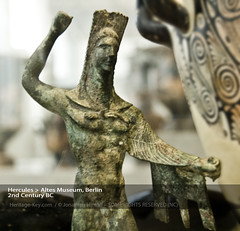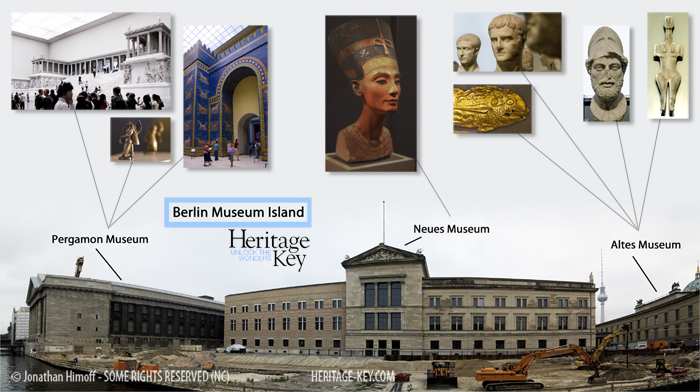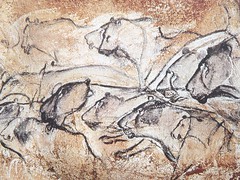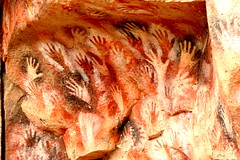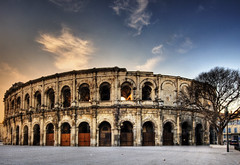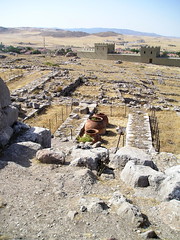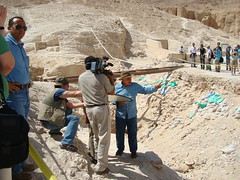The Neues Museum will reopen on 17 October after being closed for more than 70 years. It will be a great moment in German history as well as a major milestone for world culture. The collection of ancient world objects is outstanding, and their presentation helps place them in the context of their original era, whilst adding to our understanding of the world in which we now live.
 The renovation of the 8,000 square meter museum cost about 220 million (about $328 million and a lot more than the brand new build the New Acropolis Museum, which reportedly cost $200 million).
The renovation of the 8,000 square meter museum cost about 220 million (about $328 million and a lot more than the brand new build the New Acropolis Museum, which reportedly cost $200 million).
There are more than 9,000 objects on display with large collections from pre-history and ancient Egypt. The collections are mainly shown thematically, often by contrasting objects, which works well and engages the visitor. The Neues Museum is part of the Berlin Museum Island which now can be considered to be one of the best – if not the best – ancient world destinations in Europe.
Neues Museum Re-Opens, Germany Re-Connects History
Enter the Neues Museum and be ready to travel across time. Run your hand across the Soviet bullet holes in the exterior walls, and think about what this building has witnessed since it first opened in 1859. Consider the Prussian ambitions that ended in Nazi realities. Does history endlessly repeat itself, from power and rebellion in the era of Akhenaten to the time of the Romans to lives of the Romanovs?
We have won this building back from ruins, says Michael Eissenhauer, General Director of the National Museums in Berlin (SMB). Perhaps Germany, a leading world economy already, can mark also having won itself back too with this opening, 20 years on from pulling down the Wall. In the 19th century, Bismark wanted to show the world that Germany was among the world powers by having it’s own collection of masterpieces across history. What Germany could never achieve in War it may have gained in Peace.
The Renovation of the Neues Museum
Clearly thrilled to finally be able to share the Neues with the public, Eissenhauer explains: No one could have expected this complete renovation to have happened. Neues is part of five historical buildings that were like a row of pearls, but all damaged during the War. The first shell hit the Neues Museum in 1943 near where the minimalist main staircase now carries you up toward the Nefertiti Dome gallery (watch a slideshow of the Queen on display in room 210). By 1945 an entire third of this architecturally significant 19th century building was destroyed. The building lay in weed-infested shambles for more than 40 years.
David Chipperfield, the UK architect who won the competition for the design, had an almost unsolvable task, continues Eissenhauer. How to restore the builidng while maintaining the work of the original architect Friedrich August Stler. When we started the renovation there was a tree in the middle of the site that was more than 30 years old
The German Democratic Republic (Die Deutsche Demokratische Republik, DDR) made some attempt to redevelop the Museum complex, but mainly all they were able to do was open the Pergamon Altar (which actually I saw in 1985).
Eissenhauer credits Chipperfield with staying true to the spirt of the technical innovations that the building reflected back in the 19th Century (see a collection of images of the Neues before the War here):
Chipperfield was able to withdraw himself from the need to make his own statement in the renovation. Instead he treated the design with great respect and focused on the functions that the new rooms had to deliver.
But it is not an easy design to appreciate on a first visit. Eissenhauer shared with me that his initial impression was not very positive. At first I even felt very lost entering room 108. The function though is to store tombs and now that the artefacts and walls are installed everything fits. Architecture has delivered the purpose of the room without getting in the way of the content. I must say though that I shared his first impression and room 108 and the rest of the new sections left me cold compared to the restored areas. So another good reason to go back! Maybe it gets even better.
More images from the press conference at the Neues Museum:
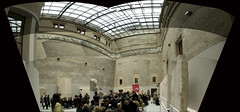
Panorama view of the Greek Courtyard at the Neues Museum where the re-opening press conference was held on 15th October 2009
 Michael Eissenhauser, General Director National Museums Berlin (left), Matthias Wemhoff, Director of Museum of Prehistory and Early History (right)
Michael Eissenhauser, General Director National Museums Berlin (left), Matthias Wemhoff, Director of Museum of Prehistory and Early History (right)

Friederike Seyfried, Director Egyptian and Papyrus Collection at Neues Museum (center) Hermann Parzinger, President of the Prussian Cultural Heritage Foundation (right), Andreas Scholl, Director Classical Antiquites (left)
The strongest visual impression I want to share is the stunning juxtaposition of the ancient Egyptian sculptures against the rich, textured walls which are quasi-restored/decorated in remains from the original building. I have tons of photos (see them here) showing the simplified Egyptian styles against really almost ‘shabby chic’ style walls . The mash-up of the straight-edge modern with the classical column peppered with more Soviet bullet holes overwhelms you in the great staircase in the center of the building. This place seems to be the heart of the design. It hits us with many signals from our learnings, notions and forces us into a new space where we can experience the impact of this significant collection fresh. Neues has the feel of an eccentric’s vast castle and you are a welcomed visitor.
Schlieman and Looted Art and Artefacts
Perhaps this is also some legacy from Henrich Schlieman, the tycoon who went in search of Homer’s heroesand perhaps found them in Mycenae and Troy. At Neues, Schlieman finally gets the stage he deserves. Yet, Schlieman is a very controversial figure, as even the Museum Guidebook points out: Schlieman violated contractual agreements with the Turkish authorities by having [the Troy] treasure transported to his house in Athens. He was ordered to pay 10,000 gold francs, but actually paid three times that amount. As a result, the treasure and many of the other artefacts became legally his property. Even 30,000 gold francs seems like quite a good deal for a priceless treasure. The discoveries at Troy, possibly from King Priam, includes 8,830 items of gold, silver, electrum and copper. According to a sign at the Museum, many of these artefacts are still in Russia.
And what about the Russians – ahem, Soviets? Why are there so many digs at their sacking the collection at the end of the war? On relations with the Russians Eissenhauer advised that they are aware of the locations of all the missing objects from the Neues Museum that were sacked at the end of the War. The Germans have access to Schlieman’s discoveries at Troy in particular, but would like to see more free exchange of research.
Nonetheless, there are some plaques on the exhibition entitled Looted Art which would suggest that there are some stronger feelings within (at least amongst the people who write the tags for exhibits – there a some more sharp comments on tags at the Pergamon Altar also) that the Russians are holding the artefacts against international law. This is of course wobbly ground with respect to the Germans’ still questionable claim to the bust of Nefertiti – as well as invading countries during the War and other actions that were against international law as well.
German Chancellor Merkel will be making a formal opening speech on 16 October at the larger space over at the Pergamon Museum. No doubt she will take the chance to appreciate this moment in re-connecting Germany with the best parts of its own heritage as well as welcome the world to Berlin to discover the great heritage common to us all.


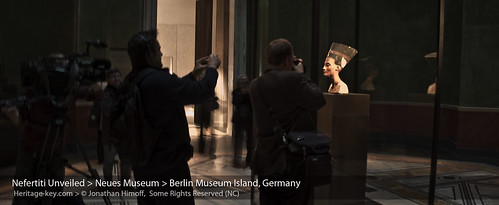
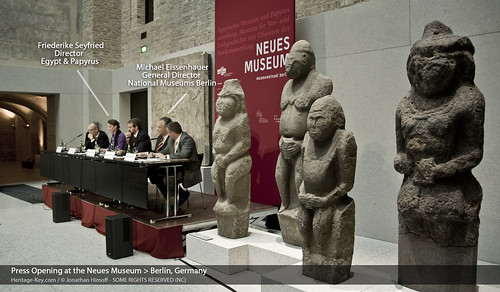

 The Gold Hat is a spectacular item: according to the Neues: “Golden hats were most likely used as cult objects and worn over a period of hundreds of years by political or religious leaders during ceremonial and cultural events. Only four golden hats stemming from the Bronze Age survive in Europe today. The Berlin Gold Hat is made from gold leaf, hammered until wafer-thin. The conical hat is adorned with chased patterns arranged to form horizontal bands.”
The Gold Hat is a spectacular item: according to the Neues: “Golden hats were most likely used as cult objects and worn over a period of hundreds of years by political or religious leaders during ceremonial and cultural events. Only four golden hats stemming from the Bronze Age survive in Europe today. The Berlin Gold Hat is made from gold leaf, hammered until wafer-thin. The conical hat is adorned with chased patterns arranged to form horizontal bands.”
